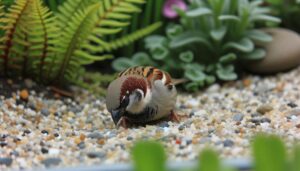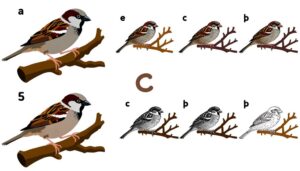5 Common Names for the House Sparrow
The House Sparrow (Passer domesticus) is often called the English Sparrow and colloquially referred to as Spadger. In various languages, it maintains a straightforward designation: Haussperling in German, Moineau domestique in French, Gorrión común in Spanish, and Passero domestico in Italian.
These nomenclatures underscore the species' ubiquitous nature and robust adaptability to urban environments. Cultural significance attached to these names offers insights into historical presence and societal connections.
For deeper exploration into the house sparrow's adaptability, population dynamics, and cultural symbolism, there are further fascinating aspects to examine.

Key Takeaways
- Common names for House Sparrow include English Sparrow, Spadger, and Passero Domestico.
- The House Sparrow is also known as Haussperling in German and Moineau Domestique in French.
- In Spanish-speaking regions, the House Sparrow is called Gorrión Común.
- These names reflect the bird's adaptability and close association with human settlements.
- The varied nomenclature underscores the global presence and cultural significance of the House Sparrow.
English Sparrow
The House Sparrow (Passer domesticus), commonly referred to as the English Sparrow, is a species that has been extensively studied due to its widespread presence and adaptability to urban environments. Originating from Europe, this species was introduced to North America in the mid-19th century and has since proliferated across various continents.
Detailed observational data indicate their preference for nesting in man-made structures and their omnivorous diet, which includes grains, insects, and human food waste. Population studies reveal that English Sparrows exhibit high reproductive rates, with multiple broods per year.
Their ability to thrive in diverse habitats, from rural to highly urbanized areas, underscores their ecological versatility. This adaptability has implications for urban biodiversity and pest management strategies.
Spadger
Commonly known as a 'spadger' in various regional dialects, the House Sparrow exhibits remarkable adaptability to different environmental conditions, a trait that has been well-documented through extensive field studies. The nomenclature 'spadger' reflects the bird's colloquial recognition in rural and urban areas alike. This adaptability is supported by data demonstrating the House Sparrow's presence in diverse habitats from urban centers to agricultural landscapes. Their broad diet and nesting flexibility further underline their resilience.
| Observation Type | Data Points | Conclusion |
|---|---|---|
| Habitat Range | Urban, Rural, Agricultural | Highly adaptable |
| Diet | Seeds, Insects, Human food | Omnivorous flexibility |
| Nesting Sites | Buildings, Trees, Shrubs | Versatile nesting |
Such characteristics affirm the House Sparrow's ecological success across varied environments.
House Sparrow in German
Known in German as the 'Haussperling', the House Sparrow occupies a significant role in avian studies due to its extensive distribution and adaptability. The species, Passer domesticus, exhibits remarkable ecological plasticity, inhabiting urban, suburban, and rural environments across Germany.
This bird's population dynamics and breeding habits are subjects of numerous ornithological research studies. Data indicate that the Haussperling is a robust indicator of environmental health, often correlating with urban biodiversity indices. Morphologically, it displays sexual dimorphism: males possess distinctive black bibs, while females exhibit more subdued plumage.
Studies on its foraging behavior reveal a diet mainly consisting of grains and insects, underscoring its role in pest control and seed dispersal within German ecosystems.
House Sparrow in French
In French, the House Sparrow is commonly referred to as 'moineau domestique,' a term that directly translates to 'domestic sparrow.' Pronounced [mwa-no doh-mehs-teek], this nomenclature is widely utilized in both ornithological literature and everyday language across French-speaking regions.
Data from avian population studies indicate that the term's usage is consistent, reflecting the species' ubiquity in urban and rural environments.
French Common Names
The House Sparrow, scientifically named *Passer domesticus*, is referred to as 'moineau domestique' in French. This nomenclature is widely recognized across Francophone regions and is consistent with the bird's global distribution.
Observational studies indicate that the *moineau domestique* is ubiquitous in urban environments, adapting well to human-modified habitats.
Key aspects of its presence in French-speaking territories include:
- Habitat Adaptability: Thrives in both rural and urban settings.
- Dietary Patterns: Primarily granivorous, but also consumes insects and food scraps.
- Behavioral Traits: Exhibits strong social behavior, often seen in flocks.
These data points illustrate the adaptability and resilience of the *moineau domestique*, making it a familiar sight across various environments in French-speaking countries.
Pronunciation and Usage
One notable characteristic of the French common name for the House Sparrow, 'moineau domestique,' is its phonetic clarity, which facilitates consistent pronunciation among native speakers.
The term 'moineau' (/mwa.no/) follows a straightforward syllabic pattern, promoting ease of articulation. According to linguistic data, this phonetic uniformity aids in reducing regional variations and mispronunciations.
Moreover, 'domestique' (/dɔ.mɛs.tik/) adheres to standard French pronunciation rules, enhancing its recognition and reproducibility.
Usage data suggests that 'moineau domestique' is prevalently employed in both formal ornithological texts and colloquial speech, indicating its widespread acceptance.
This nomenclature's simplicity and clarity contribute to its effective communication of the species identity, ensuring accurate identification and discussion within scientific and public domains.
House Sparrow in Spanish
In Spanish, the House Sparrow (Passer domesticus) is commonly referred to as 'gorrión común.'
Particularly, regional variations in nomenclature exist, with terms such as 'pardal' being used in certain areas of Spain and Latin America.
These variations reflect the bird's widespread presence and cultural significance across diverse Spanish-speaking regions.
Spanish Common Names
House Sparrow (Passer domesticus) is commonly referred to as 'gorrión común' in Spanish-speaking regions, reflecting its widespread presence and familiarity. This nomenclature underscores the species' adaptability and omnipresence in urban and rural habitats. The term 'común' signifies its status as a prevalent avian species, encountered frequently across various environments.
Habitat Preferences: Gorrión común thrives in diverse habitats, including agricultural areas, urban settings, and woodlands.
Population Data: Studies indicate a stable population trend in Spain, despite mild fluctuations due to habitat changes.
Dietary Habits: Primarily granivorous, the gorrión común also consumes insects, providing a balanced nutritional intake which supports its robust population numbers.
These characteristics highlight the ecological and cultural significance of the House Sparrow in Spanish-speaking territories.
Regional Name Variations
Regional variations in the nomenclature of the House Sparrow (Passer domesticus) across Spanish-speaking areas reflect linguistic diversity and local cultural influences.
In Spain, it is commonly referred to as 'gorrión común,' while in Mexico, the term 'gorrión chico' is frequently used.
Argentina favors 'gorrión' without any modification.
Importantly, in Chile, the bird is often called 'chincol,' derived from indigenous Mapuche language influences.
Detailed observations reveal these terminological differences are not merely linguistic but are deeply embedded in the cultural and ecological contexts of each region.
For instance, 'chincol' in Chile not only refers to the House Sparrow but also to other similar small birds, illustrating a broader application of the term based on local avian biodiversity.
House Sparrow in Italian
The house sparrow, known scientifically as *Passer domesticus*, is referred to as 'passero domestico' in Italian. This nomenclature aligns with the species' ubiquitous presence in domestic and urban environments throughout Italy.
Studies indicate that *Passer domesticus* populations in Italy exhibit robust adaptability to varied habitats, from rural farmlands to densely populated cities.
Key observations include:
- Habitat Utilization: *Passero domestico* is often found nesting in man-made structures, a behavior that underscores its adaptability.
- Dietary Preferences: Italian populations of *Passer domesticus* display an omnivorous diet, consuming grains, insects, and urban food waste.
- Population Dynamics: Data from ornithological surveys show stable to slightly increasing population trends in urban areas, contrasting with declines in rural settings.
These factors highlight the species' resilience and integration into Italian ecosystems.
Cultural Significance of Names
Understanding the cultural significance of names attributed to the house sparrow (*Passer domesticus*) requires an examination of historical, linguistic, and societal contexts. Historically, this avian species has been ubiquitous in human settlements, leading to its portrayal in folklore and literature across various cultures.
Linguistically, regional names often reflect specific behaviors or physical traits observed by local populations. For example, in some European languages, names translate to 'little sparrow,' emphasizing its diminutive size.
Societal contexts further add layers; in many cultures, the house sparrow is a symbol of simplicity and resilience, often appearing in proverbs and idioms. Consequently, the nomenclature of the house sparrow is not merely a linguistic label but a window into the societal values and historical interactions of human communities.
Conclusion
Ironically, despite the house sparrow's varying appellations—English Sparrow, Spadger, Haussperling, Moineau domestique, Gorrión común, and Passero domestico—the species remains universally recognizable and ubiquitous. Such linguistic diversity underscores the bird's global presence yet highlights a paradox: a creature so ordinary that its myriad names only amplify its commonness.
This serves as a poignant reminder of humanity's tendency to both venerate and overlook the familiar, encapsulating the duality of significance imbued in nomenclature.






